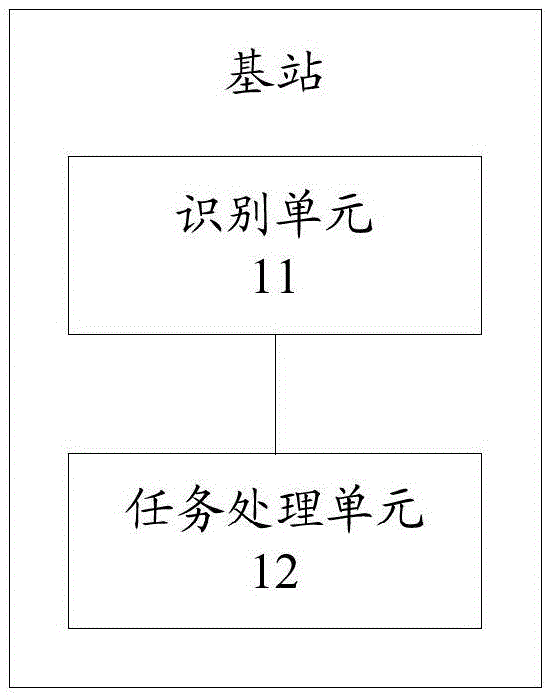Data processing method and base station
A technology for base station and task processing, applied in electrical digital data processing, digital transmission system, network traffic/resource management, etc. question
- Summary
- Abstract
- Description
- Claims
- Application Information
AI Technical Summary
Problems solved by technology
Method used
Image
Examples
Embodiment 1
[0047] An embodiment of the present invention provides a base station. figure 1 It is a schematic diagram of the composition and structure of the base station of the embodiment of the present invention; figure 1 As shown, the base station includes: the base station includes: an identification unit 11 and a task processing unit 12; the number of the task processing units 12 is more than two, and the tasks that the more than two task processing units 12 support are processed as scheduled It is assumed that the task cycle gradient is divided so that the two or more task processing units 12 support processing tasks in different task cycle ranges; wherein,
[0048] The identification unit 11 is configured to obtain a task, identify the period of the task, and send the task to the corresponding task processing unit 12 for processing based on the period of the task;
[0049] The task processing unit 12 is configured to obtain and process the task sent by the recognition unit 11 .
...
Embodiment 2
[0063] Based on Embodiment 1, the embodiment of the present invention also provides a base station, Figure 4 It is a schematic diagram of the composition structure of more than two task processing units in the base station of the embodiment of the present invention; Figure 4 As shown, the RRM unit includes at least two RRM subunits, and the tasks supported by the at least two RRM subunits are divided according to the first preset task cycle gradient; wherein, the first preset task cycle gradient is The included task period range is greater than or equal to the first threshold;
[0064] Then the at least two RRM subunits are used to process tasks whose task period is within the range of the corresponding task period;
[0065] The slow MAC unit includes at least two slow MAC subunits, and the tasks supported by the at least two slow MAC subunits are divided according to the second preset task cycle gradient; wherein, the second preset task The task period range included in t...
Embodiment 3
[0074] Based on the above-mentioned base station, an embodiment of the present invention also provides a data transmission method, the data transmission method is applied to a base station, and the base station includes more than two task processing units, and the two or more task processing units support processing Tasks are divided according to preset task period gradients, so that the two or more task processing units support processing tasks in different task period ranges. Figure 5 It is a schematic flow chart of a data transmission method in an embodiment of the present invention, such as Figure 5 As shown, the data transmission method includes:
[0075] Step 501: The identification unit of the base station obtains a task, and identifies a period of the task.
[0076] Step 502: The identifying unit of the base station distributes the task to a task processing unit corresponding to a period of the task for processing.
[0077] In this embodiment, the task obtained by ...
PUM
 Login to View More
Login to View More Abstract
Description
Claims
Application Information
 Login to View More
Login to View More - R&D
- Intellectual Property
- Life Sciences
- Materials
- Tech Scout
- Unparalleled Data Quality
- Higher Quality Content
- 60% Fewer Hallucinations
Browse by: Latest US Patents, China's latest patents, Technical Efficacy Thesaurus, Application Domain, Technology Topic, Popular Technical Reports.
© 2025 PatSnap. All rights reserved.Legal|Privacy policy|Modern Slavery Act Transparency Statement|Sitemap|About US| Contact US: help@patsnap.com



